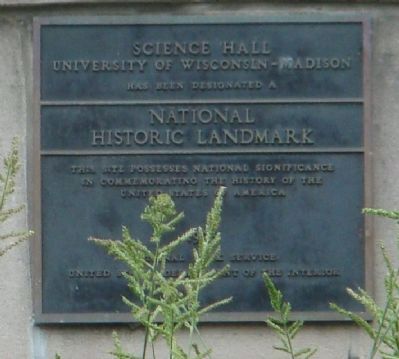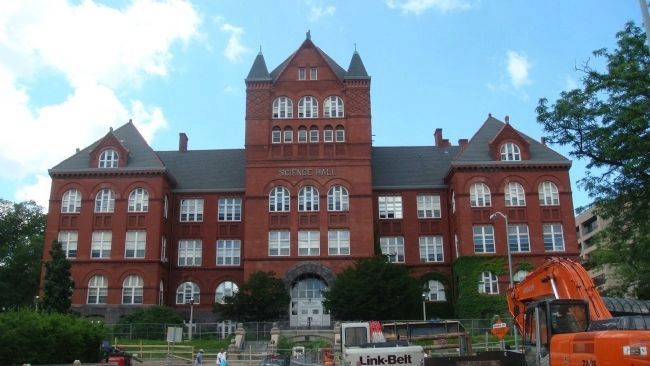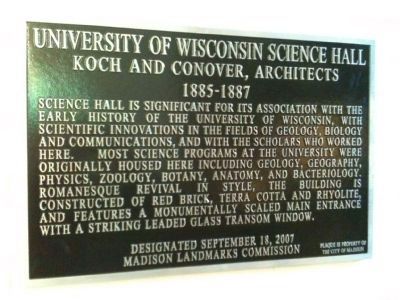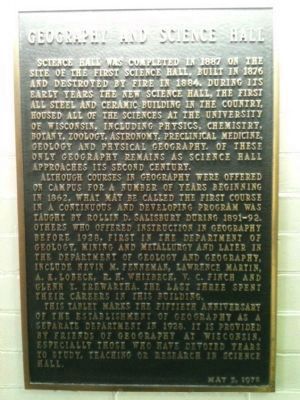Madison in Dane County, Wisconsin — The American Midwest (Great Lakes)
Science Hall
University of Wisconsin - Madison
Science Hall, University of Wisconsin - Madison, has been designated a National Historic Landmark. This site possesses national significance in commemorating the history of the United States of America.
Erected 1993 by National Park Service - United States Department of the Interior.
Topics and series. This historical marker is listed in this topic list: Education. In addition, it is included in the National Historic Landmarks, and the Wisconsin, Madison Landmarks Commission series lists.
Location. 43° 4.554′ N, 89° 24.052′ W. Marker is in Madison, Wisconsin, in Dane County. Marker is at the intersection of North Park Street and Langdon Street, on the left when traveling north on North Park Street. Touch for map. Marker is at or near this postal address: 550 North Park Street, Madison WI 53706, United States of America. Touch for directions.
Other nearby markers. At least 8 other markers are within walking distance of this marker. Leaders in Science (a few steps from this marker); On the Air (within shouting distance of this marker); State Historical Society (about 400 feet away, measured in a direct line); A Living Room for Campus (about 400 feet away); Securing the Future (about 500 feet away); The American Character (about 500 feet away); A Grand Experiment (about 500 feet away); Robert E. Gard Memorial Storyteller's Circle (about 600 feet away). Touch for a list and map of all markers in Madison.
Regarding Science Hall. According to the Madison Landmarks Commission, which designated Science Hall as a landmark (no. 170) in 2007, it was designed by architect Henry C Koch, altered by architect Allan Conover, and built 1885-1887. Moreover, "Science Hall is a three-story u-shaped Romanesque Revival structure with a gable roof, featuring a rock-faced coursed rhyolite ashlar raised basement and walls of red-pressed brick in common bond. The building is enriched with ornamental brickwork and belt courses of rhyolite and glazed red terra cotta.
"Science Hall is associated with Charles R. Van Hise (1857-1918), who was the first geologist in the Nation to apply microscopic lithology to the extensive study of crystalline rocks, and to use those results in the formulation of geological principles. Van Hise's emphasis on the quantitative application of physical and chemical laws to geological problems was one of his greatest contributions to the science of geology. His influential 1904 monograph, A Treatise
on Metamorphism, moved geology out of the science of classification and into formulating principles. As a teacher, Van Hise earned a reputation for training geologists who matched his own high standards in scientific research.
"In addition, it was in Science Hall that Wisconsin Physics Professors Earle M. Terry and Edward Bennett, along with their students, carried out research that contributed to the development of radio from wireless telegraphy. In the basement of Science Hall, Terry and his students [developed] the beginnings of telegraphic station 9XM, which eventually became WHA radio, the oldest continuously operating radio station in the nation."
According to David V. Mollenhoff, Madison: A History of the Formative Years (2nd ed.), p. 220, Frank Lloyd Wright worked on Science Hall, before he became an architect, while employed by Allan Conover. Also, "Science Hall was one of the first buildings in the United States to use steel for structural framing and may be the oldest extant building in the country with this feature. The use of steel was no accident; Conover was keenly interested in new construction technologies, and in the 1880s steel was at the cutting edge. Wright especially appreciated Conover's architectural ingenuity and savored the opportunity to see his mentor's mind at work. These experiences allowed Wright to examine the work of other
architects and to see plans transformed into buildings. A final benefit of his employment with Conover was the engineer's practice of delegating remarkably responsible work to young subordinates. For example, Conover sent Wright scampering to the top of Science Hall on steel girders to replace a clip. No wonder Wright later said that of all his employers, it was from Conover that he 'learned the most.'"
Related markers. Click here for a list of markers that are related to this marker. This is a list of markers for buildings designed by Conover.
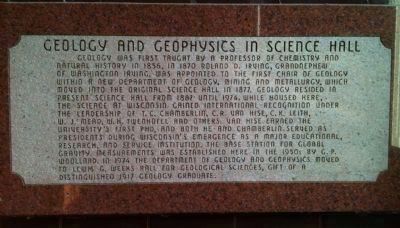
Photographed By William J. Toman, April 13, 2012
6. Geology and Geophysics in Science Hall Marker
This marker is to the right just inside the front entrance of Science Hall, and reads as follows:
Geology was first taught by a professor of chemistry and natural history in 1856. In 1870 Roland D. Irving, grandnephew of Washington Irving, was appointed to the first chair of geology within a new Department of Geology, Mining and Metallurgy, which moved into the original Science Hall in 1877. Geology resided in present Science Hall from 1887 until 1974. While housed here, the science at Wisconsin gained international recognition under the leadership of T.C. Chamberlin, C.R. Van Hise, C.K. Leith, W.J. Mead, W.H. Twenhofel and others. Van Hise earned the university's first PhD, and both he and Chamberlin served as presidents during Wisconsin's emergence as a major educational, research, and science institution. The base station for global gravity measurements was established here in the 1950s by G.P. Woollard. In 1974 the Department of Geology and Geophysics moved to Lewis G. Weeks Hall for Geological Sciences, gift of a distinguished 1917 Geology graduate.
Geology was first taught by a professor of chemistry and natural history in 1856. In 1870 Roland D. Irving, grandnephew of Washington Irving, was appointed to the first chair of geology within a new Department of Geology, Mining and Metallurgy, which moved into the original Science Hall in 1877. Geology resided in present Science Hall from 1887 until 1974. While housed here, the science at Wisconsin gained international recognition under the leadership of T.C. Chamberlin, C.R. Van Hise, C.K. Leith, W.J. Mead, W.H. Twenhofel and others. Van Hise earned the university's first PhD, and both he and Chamberlin served as presidents during Wisconsin's emergence as a major educational, research, and science institution. The base station for global gravity measurements was established here in the 1950s by G.P. Woollard. In 1974 the Department of Geology and Geophysics moved to Lewis G. Weeks Hall for Geological Sciences, gift of a distinguished 1917 Geology graduate.
Credits. This page was last revised on November 16, 2022. It was originally submitted on August 2, 2010, by William J. Toman of Green Lake, Wisconsin. This page has been viewed 842 times since then and 34 times this year. Photos: 1, 2. submitted on August 2, 2010, by William J. Toman of Green Lake, Wisconsin. 3. submitted on April 15, 2012, by William J. Toman of Green Lake, Wisconsin. 4. submitted on April 13, 2012, by William J. Toman of Green Lake, Wisconsin. 5, 6. submitted on April 15, 2012, by William J. Toman of Green Lake, Wisconsin. • Syd Whittle was the editor who published this page.
